 R. Craig Collins >
Web Page Design >
Portfolio > Paris 2016
R. Craig Collins >
Web Page Design >
Portfolio > Paris 2016
May 2016, Paris/Luxembourg
July 2016, Washington DC ©
R. Craig Collins, 2016
to Washington trip
Click the date to skip down to the details
| Sunday | Monday | Tuesday | Wednesday | Thursday | Friday | Saturday |
| 15 | 16 | 17 10:30 To Austin 11:40 Arrive Parking 12:10 Check in AUS 2:11 DL4668 17 A-B 4:06 Arrive SLC 5:11 DL 88 37 A-B |
18 11:25 Arrive CDG, Customs 12:25 Depart RER B 1:25 Arrive Gare du Nord 1:45 Depart Gare du Nord 2:00 Arr Château Rouge Metro 2:15 Arr Hotel Amarys Simart |
19 Montmartre/ Sacré-Cœur Musée de la Vie Romantique Musée Carnavalet Place des Voges Hôtel de Ville Eiffel Tower |
20 Louvre Palais Royal Jardin des Tuileries -Concorde Petite Palais Marcadet-Poissioniers area Saturday, May 21, 2016 Gare De l’East-Luxembourg Hop On –Hop Off Center Ravine, Casements, Bridge Notre Dame Hop On –Hop Off, to Gare de l’East |
21 Gare De l’Est-Provins Tourist Office Tariff Barn Cesar Tower Underground Gallery Provins-Gare de l’Est Champs-Élysées, Concorde Chocolate Musée |
| 22 Gare De l’Est-Provins Tourist Office Tariff Barn Cesar Tower Underground Gallery Provins-Gare de l’Est Champs-Élysées, Concorde Chocolate Musée |
23 Notre Dame Pain des Fete Jardin Luxembourg Pantheon Roman Amphitheater Opera Montmartre |
24 5:30 Transfer CDG 6:30 Arrive CDG 8:35 DL 83 38 A-B 12:02 Arrive ATL Customs 2:35 DL 2471 3:58 Arrive AUS 4:30 Get car 5:45 Arr Home |
25 | 26 | 27 | 28 |
Huge pdf (97MB) of our 2016 Trip to Paris
Web version has fewer pictures. If you want the whole story, download the huge pdf (97MB) of our 2016 Trip to Paris
See my YouTube video of some of the moments where a still image would not do, check out:
https://www.youtube.com/watch?v=e0vtvQHjF-4
Scroll down to read about the trip, and see many of the pictures we took!
Overview, click the underlined date to jump to the details, or just scroll down to see the pictures.
Tuesday, May 17, 2016
Austin to Salt Lake City
Salt Lake City to Paris
Wednesday, May 18, 2016
Charles De Gaulle to Paris
Montmartre and Barbès Métro stations
Thursday, May 19, 2016
Montmartre/ Sacré-Cœur
Musée de la Vie Romantique
Musée Carnavalet
Place des Voges
Hôtel de Ville
Eiffel Tower
Friday, May 20, 2016
Louvre
Palais Royal
Jardin des Tuileries -Concorde
Petite Palais
Marcadet-Poissioniers area
Saturday, May 21, 2016
Gare De l’East-Luxembourg
Hop On –Hop Off
Center
Ravine, Casements, Bridge
Notre Dame
Hop On –Hop Off, to Gare de l’East
Sunday, May 22, 2016
Gare De l’Est-Provins
Tourist Office
Tariff Barn
Cesar Tower
Underground Gallery
Provins-Gare de l’Est
Champs-Élysées, Concorde
Chocolate Musée
Monday, May 23, 2016
Notre Dame
Pain des Fete
Jardin Luxembourg
Pantheon
Roman Amphitheater
Opera
Montmartre
Tuesday, May 24, 2016
Paris to Atlanta
Atlanta to Austin
Austin to Temple
Some images from Google Street view. Some historical information was rounded out with information from Expedia.
Tuesday, May 17, 2016
Up early, we both exercised and did our final pack.
10:00 am, Drove to Austin
11:15 am, Drop of car at Fast Park and Relax
11:30 am, After getting checking in at the Delta kiosk, I notice one of the zippers on by backpack is open; hopped back on one of the Fast Park buses, and rode back to the car, by my liquids bag was nowhere to be found. Back to the terminal and zipped through security, thanks to our TSA Pre√. We headed to the Austin Article shop near our gate, and bought new shampoo and lotion. Got a call from Gracie, who was there picking up Pablo, so we headed to Ray Benson’s food court and had brisket breakfast tacos. Gracie and Pablo headed out, and we headed to our gate.
1:36 pm, board.
Austin to Salt Lake City flight on the RJ 900 went fairly smoothly, and our mini luggage fit in the overhead bins where most folks had to gate check their bags. We enjoyed flying over the lake, but we arrived in Terminal B, instead of D, as we expected; so we had to run from B13 to D6. Looking at our boarding passes for the next leg, we noticed that the seats had changed since we booked, even since we had checked the night before… due to an equipment change from a 747 to a 767, so we hurriedly got that fixed and got seats together, in our desired spot of a two seat group, with one by the window. We had just a few minutes to notice how SLC is almost in a bowl, surrounded by green mountains with traces of snow on them…

We boarded right on time for our Salt Lake City to Paris flight, but we were parked at the gate for a bit as they fixed one of the toilets that was leaking to the point that we would have had no water on the flight.
5:30 pm, we took off, about 20 minutes late.
Later, our dinner was chicken Salad that Susann enjoyed, and chicken with tomato sauce that I did not.
Susann watched the movie Joy while I watched Deadpool.
About half way through the flight, we were served chicken/ turkey and cheese on a bun, and I watched the Finest Hours.
I must say, the Delta mainline aircraft were very nice… the seatback entertainment system is touch screen, with a USB port, and we could use the onboard wifi to check the Delta app to check on gates, etc., for free.
Wednesday, May 18, 2016
Sunrise was pretty spectacular, but re-watching the original Ocean’s 11 was a bit of a letdown.
Breakfast was cheese, a biscuit (cookie), juice, with coffee and tea.
11:30, landed, just a few minutes late.
12:30, clear passport control and border protection, and made the long hike across CDG to the RER station

The RER is basically a subway train that runs part of its route above ground… pretty packed with luggage and all, and some ‘interesting’ Buskers who rode along for one leg.
13:30, Approaching the Gare du Nord railway station, we could see Sacre Cœur, and then had another bit of a hike to the Métro station. Four stops north, and we exited at the Marcadet Poissoniers station.

We popped up out the station on Barbès, in the Montmartre neighborhood,
walked just one block to the south, then around the corner, and half a block up on the left to our hotel, the Amarys Simart, nestled between a laundry shop and a driving school.
13:45, An incredibly gregarious and jovial African fellow with great English checked us into room, after several attempts to find a room that had already been serviced by the staff. The down side, it was on the 5th floor, and there was no elevator. Good thing we packed lightly!
We noted the breakfast area was just to the right of the counter, and headed down the hall to the dreaded stair case. On our way up, we notice the strong smell of paint, and there was obvious work being done on the second and third floors. The stairs were a tight spiral with definite slopes to some treads, but we finally made it to the 4th floor. (In Europe, it is ground floor, then first floor, then second floor, and so on, so the 4th floor to them is the 5th floor to us… all we knew was it was a lot of stairs.
Room map not to scale… but the raised shower was right next to the toilet.
The view, looking down from the 4th floor landing, and the direction sign just behind, on the wall.
The view out the balcony window.
 |
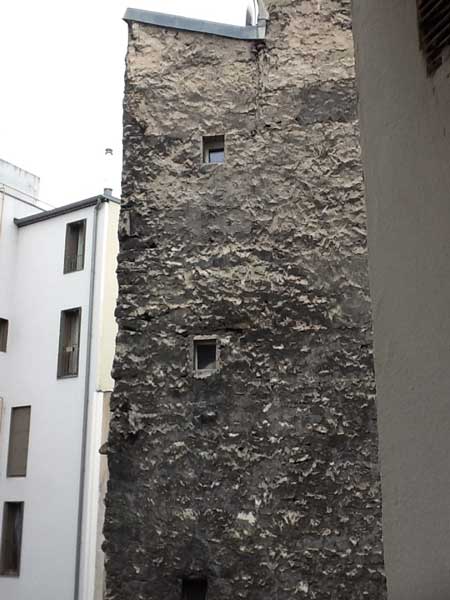 |
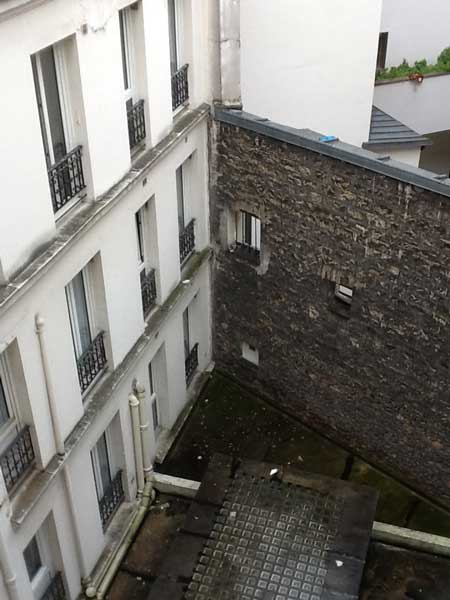 |
|
Room 46. No closet, just an open wardrobe with a few shelves and a place to hang clothes, plus a small desk.
After unpacking, we knew we’d never fall asleep later if we crashed, so off we went. From my planning before we left, I knew there was a Carrefour store just south on Barbès, so we walked just half a block down Simart to Barbès, and went south. We were a bit of a sight, picking up conditioner bottles and trying to decide which would be better. We also grabbed some instant coffee for Susann, and some cookies.
Finally we were ready to do some exploring, so walked south to the Château Rouge Métro stop and looked around, all the construction, then dropped down to the Métro station to head to Ile de Cité. For the first day, we had purchased a set of 5-zone passes… while they were good on the RER train to get us from the airport to Paris, they were also good for unlimited travel on the Métro for the rest of the day.
We popped up in the middle of the island, and walked by St. Chapelle, c. 1246, which we visited in 2005, and headed around the Palais du Justice de Paris and Conciergerie, to the north side of the island.
What had been a light mist turned in to a pretty hard down pour, so up came the hoods as we looked east toward Hotel de Ville, the old town hall.
We then walked west toward Pont Neuf.
We passed the Conciergerie and walked around the Palais du Justice de Paris.
The Conciergerie used to be a royal palace, then a prison (one prisoner of note was Marie Antoinette), but today is mostly used for Courts of Law. From the sixteenth century to the French Revolution the Palais du Justice de Paris was the seat of the Parlement de Paris.
The building was reconstructed between 1857 and 1868 and was opened in October 1868. It was awarded the Grand Prix de l'Empereur as the greatest work of art produced in France in that decade.
Pont Neuf

By now we were getting soaked, so back to the Métro, and we rode up to hotel, to drop off our stuff. We had seen a lot of cheap food shops near Château Rouge, so now armed with umbrellas, we headed down and we found a place that had chicken, drink (Orangina), and an ice cream sundae dessert for €10 for both of us.
We then walked south on Barbès just to explore. We then went into the Barbès – Rochechouart station on Paris Métro Line 2 and Line 4, at the point where the 9th, 10th, and 18th arrondissements all share a single point. The 4 line we needed was below ground, but at this point the 2 line ran above ground.
18:00, back to the hotel, up the stairs, and settled in for the evening. We left the balcony door open for a bit to let the paint fumes clear. The wifi was a bit weak, but the iPad was able to upload the few pictures I had taken. The blackout curtains certainly helped, as the sun stayed up until about 22:00 at this latitude.
Thursday, May 19, 2016
While the bed was comfortable, the bath was pretty much a joke. The old place had the shower raised about 1 foot up, I supposed to allow room for plumbing, and the toilet took ages to fill. I’m not sure the place was to American plumbing code, as there was often a slight sewer gas odor, but not too big a deal as we did not spend a lot of time in there. Another small issue was that I had to go downstairs each day and borrow one of the two or three hair dryers they had for the entire place. Not a big deal if you have an elevator, we did not.
7:00 down for breakfast. The hotel breakfast, which we got as part of our special booking, included: juice, coffee or tea, French bread, cheese or Nutella, croissants, cereal, and a pastry with apple and chocolate.
9:30, in light rain we walked half a block down Simart to Barbès, then up a block to one the two Métro station entrances.
We now started using our 5 day, 3 zone passes. Great deal, but boy were they hard to keep track off, they were perhaps .75” wide and maybe 2” long.

We rode the Métro to Barbès – Rochechouart, then changed lines and rode to Blanche, coming out right across from the Moulin Rouge. Our original plan was to ride the Petit Train around Montmartre to Sacré-Cœur, but it was a few minutes before the train supposedly started running so we walked around the sex shops and tree lined boulevards for a bit, getting to Place de Clichy, then reversing and walking to Pigalle before heading back to Blanche.
The Moulin Rouge first built in 1889, is best known as the spiritual birthplace of the modern form of the can-can dance. Originally introduced as a seductive dance by the courtesans who operated from the site, the can-can dance revue evolved into a form of entertainment of its own and a place loved by artists, of whom the most iconic was Toulouse-Lautrec. His posters and paintings secured rapid and international fame for the Moulin Rouge. Which led to the introduction of cabarets across Europe. Today, the club's decor still contains much of the romance of fin de siècle France.
After a bit, it was pretty obvious the train was not going to run in the rain, so we hopped back on the Métro, rode to Anvers, and popped up at the base of Montmartre, looking up at Sacré-Cœur.
There were close to 100 stairs to get up to the basilica, but we stopped several times to admire the views, appreciate the fountains, and perhaps to catch our breath.
Sacré-Cœur is not all that old. A popular landmark, the basilica is located at the summit of the butte Montmartre, the highest point in the city. Sacré-Cœur is a both a political and cultural monument. The Basilica was designed by Paul Abadie; construction began in 1875 and was finished in 1914. However, it was consecrated after the end of World War I in 1919.
The interior of Sacré-Cœur.
A model of Sacré-Cœur
Sacré-Cœur is built of travertine stone quarried in Château-Landon (Seine-et-Marne), France. This stone constantly exudes calcite, which ensures that the basilica remains white even with weathering and pollution.
For our Montmartre walking tour, we followed a route from http://www.aparisguide.com/montmartre/
Another nearby church is even more interesting historically is the Church of St. Pierre which is one of the oldest in Paris and even contains some original Roman columns. (they say Dante came here to pray).
The name Montmartre was originally Roman meaning "Mount of Mars" but was later changed by less pagan French to "Mount of Martyrs" or Montmartre.
Across the street is the Place du Tertre where the legends of 20th century art used to roam. Now it's filled with watercolors, portrait sketchers and caricaturists. You can't blame them for trying to make some money, and a few are actually good artists who need money, but for the most part it reminds us of that lost generation of artists who lived and worked here before the commercialization of everything. Picasso, Vlamenck, Derain, Soutine, Modigliani, Van Gogh and countless others lived and worked in these narrow streets.
We bought a map for €1 to help us navigate.
Even with the map, it was confusing at times, but we found did walk by Espace Dali at 11 Rue Poulbot.
We followed the road downhill and you will begin to enter the most interesting streets of historic Montmartre filled with narrow cobblestone streets and sometimes beautiful private gardens. Now you realize why this was truly considered a village once, set outside the city limits. At that time it was covered with vineyards and gypsum quarries and was a real working class neighborhood to which the artists came for cheap rent and tax free wine. Renoir's house is at # 6 Rue de l'Abreuvoir.
These are the only two windmills left on the hill which was once literally covered with them. The Moulin de la Galette in on the Rue Lepic which was a central and crucial street to Montmartre, as it still is. Many artists painted the Moulin de la Galette in various conditions.
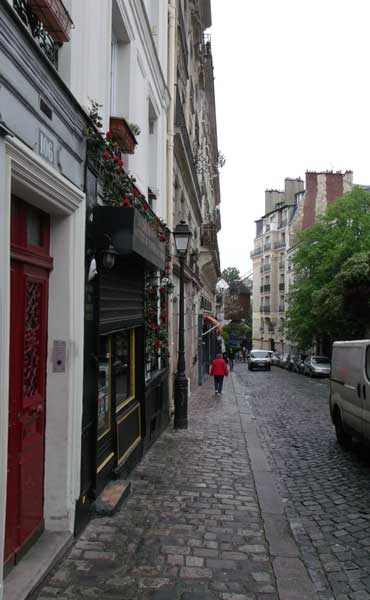
The Moulin de la Galette in on the Rue Lepic, Van Gogh lived at # 54.
Nearby was the Clos Montmartre vineyard, the Montmartre museum, and the famous Montmartre cemetery, but we decided to head down the hill to another famous spots for artists…but the way there was incredibly beautiful, as the rains let up a bit.
The famous Bateau Lavoire at #13 Place Emile-Goudeau. The birthplace of Cubism isn't open to the public, but a display in the front window details this unimposing spot's rich history.
Picasso's studio was here and at times Braque and Juan Gris, Modigliani and Apollinaire the poet all lived here. It is without a doubt the most famous art "studio" in the world. Any biography of any of these artists and poets will give you countless stories of the wild days at Bateau Lavoire.
We then made our way down to Abbesses, found the hidden Métro and a small carousel, and rode to Pigalle.
We then walked to Musée de la Vie Romantique; If you’re in Paris for the romance, there is no lovelier free place than this museum dedicated to two artists active during the Romantic era: writer George Sand and painter Ary Scheffer. Squirreled away at the end of a film-worthy cobbled lane, the villa originally belonged to Scheffer and was the setting for popular salons of the day, attended by notable figures like Delacroix, Liszt and Chopin (Sand’s lover).
We took the Blanche station Métro to Barbès – Rochechouart, then wandered up to Château Rouge looking for lunch. We settled on L’Etoile de Tunisia, which advertised Sandwiches, Patisserie Oriental, Restaurant, and Pizza.
Definitely a favorite of the community, they still welcomed us; we each had a 3 fromage pannini, shared frites, and watched with the locals about the lost Air Egypt flight. €11,50. Interesting lunch.
We walked back to the hotel to freshen up, but about then the maids arrived; so we took the Métro to the Châtelet , changed over to the 1 train to the St. Paul stop, and walked Musée Carnavalet.
The museum occupies two neighboring mansions: the Hôtel Carnavalet and the former Hôtel Le Peletier de Saint Fargeau. In 1548, Jacques des Ligneris, President of the Parliament of Paris, ordered the construction of the mansion that came to be known as the Hôtel Carnavalet. On the advice of Baron Haussmann, the man who transformed Paris in the latter half of the 19th century, the Hôtel Carnavalet was purchased by the Municipal Council of Paris in 1866; it was opened to the public in 1880. By the latter part of the 20th century, the museum was bursting at the seams. The Hôtel Le Peletier de Saint Fargeau was annexed to the Carnavalet and opened to the public in 1989.
Much of the museum was closed off, but we still found it interesting. Nearby was the Musée Cognac Jay, but they seemed to be having issues with security and there was a lot of confusion, so headed out.
We walked to Place des Voges, were Victor Hugo used to live.
Next to the Victor Hugo museum was a neat little shop with cat figures.
From here it was a short walk to the Bastille square…
Bastille square…where we caught the metro to Hôtel de Ville.
The Hôtel de Ville area has been the headquarters of Paris since 1357. In 1533, King Francis I decided to endow the city with a city hall which would be worthy of Paris, then the largest city of Europe.
In the court yard was a carousel, and a vertical soccer field, where a team advanced a ball straight up.

See my YouTube video to watch a few seconds of vertical soccer:
https://www.youtube.com/watch?v=e0vtvQHjF-4
The trick to the teams playing vertically? People acting as counter weights on the other side, going down.
A grand carousel; it even had an old Renault.
It was only midafternoon, and we were feeling pretty good, so it was back into the Métro system, as we decided to revisit the Eiffel Tower.
The last time we visited the Eiffel Tower was at night, and even though we went up into the tower that time, we really couldn’t see the tower itself; so we decided we wanted to see it, and the area, during the day.
It was a pretty long ride, and then a pretty long walk from Bir Hakeim. It seemed so close when we caught our first glance from the above ground station, but then again, it is 984 feet tall, and it throws off your sense of perspective. But there were also tons of hucksters literally playing shell games on the way over, to keep us amused. But it was worth the walk.
Constructed in 1889 as the entrance to the 1889 World's Fair, it was initially criticized by some of France's leading artists and intellectuals for its design, but it has become a global cultural icon of France and one of the most recognizable structures in the world, and almost 7 million people ascended it in 2015.
The tower is about the same height as an 81-storey building, and the tallest structure in Paris. Its base is square, measuring 410 ft on each side. During its construction, the Eiffel Tower surpassed the Washington Monument to become the tallest man-made structure in the world, a title it held for 41 years until the Chrysler Building in New York City was finished in 1930. Due to the addition of a broadcasting aerial at the top of the tower in 1957, it is now taller than the Chrysler Building, at over 1,063 feet.
See my YouTube video to watch a few seconds of me panning up the tower
https://www.youtube.com/watch?v=e0vtvQHjF-4
Our first trip to Paris started with a Seine cruise, then we walked past an arcade to the tower. We found the arcade again.
We rode back to Monmartre, and wandered around looking for something for dinner. We decided to eat at the Extra Doner kebab shop right by the Métro stop. €9 for two burgers, and frites. We then decided to scope out Gare de l’Est, and we got Susann some Starbucks for dessert. €4,20.
21:30, Back to the hotel
Friday, May 20, 2016
Standard trip down to get the hair dryer, then return when we went to breakfast. Our favorite clerk would always joke the hair dryer was for me, making any other guest at the desk laugh.
9:00, Light rain as we walked to the Métro to head to the Louvre, taking the 12 train from Marcadet-Poissoniers to Concorde, and switching to the 1 train to the Palais Royal-Musée du Louvre stop.
9:35, The Métro stop literally took you to the underground portion of the Carousel Mall adjacent to the entrance to the Louvre right under the Pyramid, so we were able to stay dry, and avoid the long line. We checked our coats, using neat touchpad lockers that allow you to set the combination, and freshen up.
10:00, We strolled to the Richelieu gallery entrance, had our tickets scanned, and picked up our audio guides.
We started on the ground floor with a temporary exhibit from Greek gods to Darth Vader, then went to the sculpture gardens and the Horses of Marley. From there we went up to the Napoleon III apartments.
Then, up to start on the paintings. There were a few wings closed, so we missed the “Lace maker,” and the “Cheat with the Ace of diamonds,” but we did get to see “Gabrielle d’Estrées and her sister.”
We headed to the Sully gallery, and saw the “Turkish Bath”; later went to Denon to see Winged Victory.
Of course the artwork is amazing, but the former palace also is beautiful.
The Louvre is horseshoe shaped, and can be a challenge to move in a logical fashion, I constantly marked up the map to keep track of where we had been, while planning a route to what to see next.
It had been fairly empty in the Richelieu and Sully galleries, but the crowds were picking up in the Denon gallery.
Of course, this is where the Mona Lisa is.
Two enigmatic smiles
13:20, Lunch in Café Mollier; quiche, baguette, and water, €15,80, plus a view of Concorde’s Ferris Wheel.
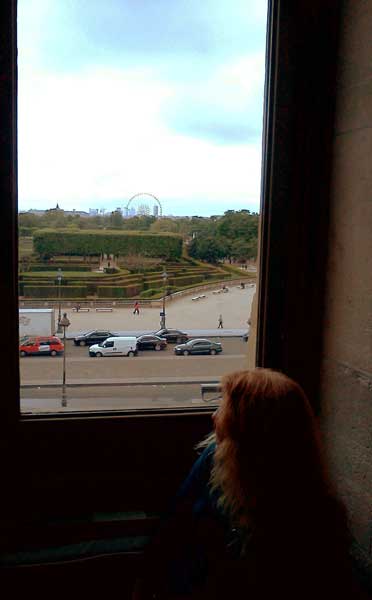
Now it was time to reverse the path, finish up Denon before moving back to Sully.
Venus De Milo
Michelangelo’s “Captive,” also known as the Dying Slave. Created between 1513 and 1516, it was to serve with the other figure, the Rebellious Slave, at the tomb of Pope Julius II. It is a marble figure 7' 4"in height
Back in Richelieu, we saw the Winged Bulls.

Code of Hammurabi.
15:30, we gathered up our jackets, headed through the mall exit, and got a great view of the grounds, before we headed through the north colonnade to visit Palais Royal. And we noted, no rain!
Palais Royal, originally called the Palais-Cardinal, the palace was the personal residence of Cardinal Richelieu. The architect Jacques Lemercier began his design in 1629; construction commenced in 1633 and was completed in 1639.Upon Richelieu's death in 1642 the palace became the property of the King and acquired the new name Palais-Royal.
After Louis XIII died the following year, it became the home of the Queen Mother Anne of Austria and her young sons Louis XIV and Philippe, duc d'Anjou.
From 1649, the palace was the residence of the exiled Henrietta Maria and Henrietta Anne Stuart, wife and daughter of the deposed King Charles I of England. The two had escaped England in the midst of the English Civil War and were sheltered by Henrietta Maria's nephew, King Louis XIV.
The larger inner courtyard, the Cour d'Honneur, has since 1986 contained Daniel Buren's site-specific art piece Les Deux Plateaux, known as Les Colonnes de Buren. In 1830 the Cour d'Honneur was enclosed to the north until the 1930s; now its flanking rows of columns are still standing between the Cour d'Honneur and the popular Palais-Royal Gardens.

Enjoying the fountain, and basking in the sun. The cutest little girl made faces at us, when she wasn’t trying to climb into the fountain.

We then headed back towards the Louvre to the Jardin des Tuileries, which are between the Louvre and Place de la Concorde.
The gardens originally were the grounds of a palace, created by Catherine de Medici in 1564; the grounds were eventually opened to the public in 1667, and became a public park after the French Revolution.
Note the Eiffel Tower and the Ferris Wheel at Place de la Concorde.
Musee de Orsay, across the Seine from the fountain in Jardin des Tuileries
The traffic was terrible around Place de la Concorde, so we decided we’d return some evening, and we headed toward the Pont Alexandre III.
Pont Alexandre III
We walked past the Grand Palais, heading to the art museum in the Petite Palais, just across the street.
The Grand Palais des Champs-Élysées, known as the Grand Palais, is an exhibition hall and museum complex located at the Champs-Élysées in the 8th arrondissement. Construction of the Grand Palais began in 1897 as part of the preparation works for the Universal Exposition of 1900, which also included the creation of the adjacent Petit Palais and Pont Alexandre III.
The Grand Palais structure was built in the style of Beaux-Arts architecture. The building reflects the movement's taste for ornate decoration through its stone facades, the formality of its floor planning and the use of techniques that were innovative at the time, such as its glass vault, its structure made of iron and light steel framing, and its use of reinforced concrete.
The Petit Palais now houses the City of Paris Museum of Fine Arts (Musée des beaux-arts de la ville de Paris).
Petit Palais on the left, Grand Palais on the right.
We then wandered to the Champs-Élysées, before heading back to Marcadet-Poissioniers.
18:00, arrived at the Marcadet-Poissioniers station, but the exit took us to new ground, at the corner of Rue Ordener and Rue des Poissioiers, near a FranPrix store.
After getting our bearings and looking through the store, we headed to the hotel, passing the Portobello Italian restaurant.
18:45, headed back to the Portobello Italian restaurant, but found they did not open until 19:00, so we wandered the ‘hood,’ south of Rue Ordener and Rue des Poissioiers. At one point the Gendarmes drove in and a bunch of folks scattered… while crowded by Château Rouge, Château Rouge was lively with the markets, folks selling peanuts they were roasting right there… this was just overly crowded and no one was really moving. So we got back to Rue Ordener, and the restaurant. Susann had Lasagna, and I had Spaghetti… neither of us really were thrilled with the food (very ‘interesting’ sauce which was very unlike marinara), or the price. €26,10. We always find it interesting how Italian and Chinese foods vary so much.
20:00, We went back to FranPrix to get snacks for the morning train trip, €2,19. We noted that signs were now up at the Métro stops announcing that Château Rouge was closing for a month.
20:15, Then back to the hotel, the rain was starting again. We were pleased to find the wifi now worked well enough for our android devices to work, so I could upload the Louvre pictures.
Saturday, May 21, 2016
Up very early, before breakfast was served… Métro to Gare De l’East, to catch our train to Luxembourg.
7:00, We got gum at Relay (€1,20) and coffee for Susann at Starbucks (€4,20).
See my YouTube video of the poles flying by on the bullet train, check out:
https://www.youtube.com/watch?v=e0vtvQHjF-4
We boarded the TGV Bullet train about 7:20, found our seats, and really marveled at how smooth the train was, even when running about 186 mph. It did slow for the last part of the journey, but very nice ride.
10:00 started looking for where the Hop On –Hop Off bus would pick us up, even Information did not know.
10:30, spotted the bus, ran to the site way to the north of the station. The station was the last stop before returning to the start point, so we rode a full loop, to get an idea of what we would hop off later, to do.
The Capital city of the Grand Duchy of Luxembourg, the center of the city is divided by a huge Ravine. Standing at the confluence of the Alzette and Pétrusse rivers, Luxembourg is one of the three European Union capital cities; housing the European Court of Justice, the European Court of Auditors, the Secretariat of the European Parliament, the European Investment Bank, the European Investment Fund, and the European Stability Mechanism, and has the second highest per capita GDP in the world.
.
It looked as if it might rain, but gradually the skies over this mix of old and new gradually cleared. The stops included on the tour were: 1. Boulevard FDR 2. Rue du Fossé 3. Montée de Clausen 4. Avenue de la Porte-Neuve 5. Rue du Fort Thüengen 6. Rue du Kiem 7. Avenue de la Porte-Neuve and 8. Railway Station
After the loop, we got off at FDR and Constitution Plaza.
Constitution square to one side, the ravine and casements to the other. .
The square, and across the street was Notre Dame, and the town center.
We looked around the plaza, and the park and casements below before heading to the Center,
where we found a celebration of the European Union, with stalls and live music
After we looked around the plaza, and the park and casements below, we headed to the Center, where we found a celebration of the European Union, with stalls and live music.
We found a restaurant called Paul (the baker) on the square, and decided to have their special, Croque Madame (ham, cheese, a Mornay sauce, topped with a fried egg), Coffee or Tea, and dessert, in our case, éclair and macaron. €27,80. Bought souvenirs, €27,75
Then it was back to the center
Then back to Constitution square, then down to the Ravine, and casements.
The Ravine, casements, and bridge. The story of the casements and park: In 963, Count Siegfried built a fortified castle on the Bock promontory, which was soon to become the cradle of the city. In the course of the centuries, on the western side, mighty ring walls were added with 24 forts, 16 other strong defensive works and a unique network of casemates: these could not only shelter thousands of soldiers and their horses, but also housed workshops, kitchens, bakeries, slaughter-houses etc.
Casemates de la Pétrusse, where we were, goes back to 1644, when the Spaniards reinforced the medieval fortifications. Initially this bastion was as high as the adjacent terraces on the right; it was raised to the present level of Constitution Square (the wall is 27 meters high) by Vauban in 1685. In 1673 the Spaniards erected the so-called "Ravelin du Pate" to strengthen the defense of the Beck Bastion; this triangular construction is one of the few well-kept fortifications. Marshall de Vauban conferred the present shape to all the Petrusse fortifications and built the "Small Staircase". From 1728-29 the Austrians added the "Bourbon Lock" and the "Large Staircase" and in 1746 the casemates of the "Petrusse Battery" (54 gun emplacements). One century passed and the fortress was enlarged and reinforced: the second ring was extended and the third started, so that Luxembourg became the "Gibraltar of the North". By and by, the Petrusse fortifications fell into neglect, as their strategic momentum limited itself to the valley. It was to be shuttered, stipulated by the 1867 London Treaty, so they began walling up the most entrances.
In 1875, the superstructure of the Bock, a tremendous construction, was razed. However, it proved to be impossible to blow up the casemates, without also demolishing part of the city. So, today, 17 kilometres of tunnels remain, often on different levels and tremendous stairways penetrate up to 40 metres inside the rock face.
The Casemates de la Pétrusse, where we were, has so much lush flora. . . .
Adolphe Bridge: The bridge takes road traffic across the Pétrusse, connecting Boulevard Royal, in Ville Haute, to Avenue de la Liberté, in Gare. 17.2 m wide, it has twin parallel 84.65 m arches in the centre, surmounted by eight smaller arches of 5.40 m each.
Adolphe Bridge has become an unofficial national symbol of sorts,and was built between 1900 and 1903.
The bridge was named after Grand Duke Adolphe, who reigned Luxembourg from 1890 until 1905.
Recall, to see more pictures, download the huge pdf (97MB) of our 2016 Trip to Paris
We headed back up to Constitution square, and decided to visit Notre Dame.
On our way we saw all manner of expensive cars, such Lamborghinis, and this exotic (in Europe) Shelby 350 Cobra.
Notre Dame .
Notre Dame of Luxembourg's cornerstone was laid in 1613.
The church is a noteworthy example of late gothic architecture; however, it also has many Renaissance elements and adornments. At the end of the 18th century, the church received the miraculous image of the Maria Consolatrix Afflictorum, the patron saint of both the city and the nation.
Around 50 years later, the church was consecrated as the Church of Our Lady and in 1870, it was elevated by Pope Pius IX to the Cathedral of Notre-Dame. It is the only cathedral in Luxembourg.
15:00, We headed back to Constitution Square, and traded in our voucher for tickets to get back on the
Hop On-Hop Off bus, and rode around one more time, so we could get some pictures of sites we had seen on the first run.
Loved the working phone booths.
Where Patton’s HQ was in WWII, he is buried nearby.
Luxembourg’s arena, the Coque
The Tall Banker sculpture
The walking flower sculpture.
Monument to the Steel industry.
EU flags.
Glowing flowers at the Museum of Art Wonderful architecture .
The State owned Savings Bank, Banque et Caisse d'Épargne de l'État (abbreviated short BCEE), with its tower, is in the former Hôtel de la Caisse d'Epargne, was constructed in the centre of Luxembourg City on the Place de Metz in 1909
.
Headquarters of a Steel conglomeration.
Rousegartchen, the Rose Garden. Roses used to be a very large export business in Luxembourg.
Back to the Gare.
16:00, Now back at the Gare, we decided to explore a bit, and walked back to the Ravine.
Back at the Gare, we paid to use the toilettes (€1,70), and grabbed a salami sandwich (€6,00) to eat with the snacks on the train back from Luxembourg to Gare de l’East.
18:09, boarded the train, and found our seats faced backward.
22:00 Éclairs, €4,00, Le Pain en fete, by the Métro. Nice birthday treat for Susann before we crashed.
Sunday, May 22, 2016
Standard breakfast, but Nutella instead of cheese on the plates.
9:30 Arrive at Gare de l’Est, but instead of the trains to Provins running every hour, today they are running every two hours. Toilettes €1,40.
Purchased the two trip Zone 5 ticket for the P train, €33,20, and wait.
Gare De l’Est-Provins
10:25 Gate announcement, and we board the train… no one checks our tickets.
10:46 train departs… slow train but nice country side. See my YouTube video of snippets of the country side, check out:
https://www.youtube.com/watch?v=e0vtvQHjF-4
12:10 Arrive in Provins.
Just outside the small station, we found the electric bus that runs around the city, and as it was raining, we-bought two day passes, €4,00 each.
We rode to the tourist office and bought our Provins passes, total €24,00 total.
.
From the Tourist Office, we walked towards the old ramparts.
Provins, a well preserved medieval town, became a UNESCO World Heritage Site in 2001. The town is divided into an Upper Town and a Lower Town, respectively called the Châtel (Castel) and the Val (Valley).
The town’s importance is confirmed in 802, when Charlemagne sent his “missi dominici” -Étienne, Count of Paris, and Fardufle, abbot of Saint-Denis- to Provins. This period coincides with the earliest military architecture in Provins.
In 996, during the reign of Hugues Capet, the relics of Saint Ayoul were miraculously discovered in the Val. A number of religious buildings were erected on site and the marshland was completely drained.
This is also when the first Counts of Vermandois were born, which gave rise to the Counts of Champagne.
Provins was home to one of the Champagne fairs that were crucial to the medieval European economy, when the city was under the protection of Counts of Champagne.
Provins even minted its own coinage, and the denier provinois (Provins’ penny) was recognized and accepted throughout medieval Europe.
The town was at the height of its fame during the reign of Thibaud IV of Champagne (1201-1253), a vassal of the French Kings Philippe Auguste (1165-1223) and Saint-Louis (1214-1270).
Approaching the city walls, from the Tourist Office.
.
The city walls.
Our first stop was the Tithe barn.
Tariff, or Thithe Barn
Upstairs in the Tithe Barn
.
Down stairs of the Tithe barn.
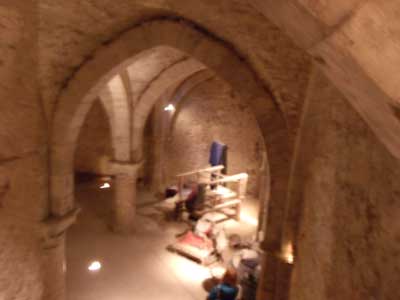
Then it was through town, to Cesar Tower.
The old homes were unbelievable, but then we got to Cesar Tower.
Cesar Tower
.
We had a so much fun on all the narrow stairs, but it was time to head to our 14:00 appointment for the English guided tour of Underground Gallery, and it really started to rain.
The guide’s English was better than our French, but she made her point.
.The Black room, used by Free Masons.
Graffiti
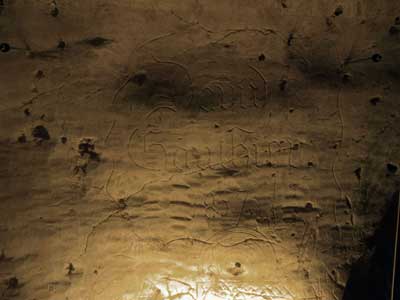
15:15, when we were exiting the Underground Gallery, we knew it would be rough outside because it was ‘raining’ in the galleries… water was seeping in so hard we knew the rain out was going to be miserable. We retraced our steps to the town square and had lunch at Petite Ecu.
French style hamburgers, with interesting greens and cheese, a red wine sauce, and just about beef tartar. €21,80.
We knew the trains were limited, so it was back to the tourist office to pick up a few souvenirs €2, the wait for the electric bus to take us back to the Gare.

16:46 We boarded, and each of the stops the train got fuller, to the point that people we standing for the last leg to Gare de l’Est.
18:10, got off the train and found out that this is where they checked tickets, to get out of the stockade.
We wandered around the station area in the rain, and decided to go back in the station where there was a small Paul café. We had quiche and macaron for €18,20, the made a trip to the toilette for €1,40 before heading to the Métro side, to ride to the Champs-Élysées.
Saw some Syrian refuges, so we gave them some change, and then we walked up to the FDR Métro stop, and rode to Place de la Concorde, which is the largest square in the French capital.
The place was designed by Ange-Jacques Gabriel in 1755 as a moat-skirted octagon between the Champs-Élysées to the west and the Tuileries Garden to the east. Decorated with statues and fountains, the area was named Place Louis XV to honor the king at that time. The square showcased an equestrian statue of the king, which had been commissioned in 1748 by the city of Paris, sculpted mostly by Edmé Bouchardon, and completed by Jean-Baptiste Pigalle after the death of Bouchardon.
At the north end, two magnificent identical stone buildings were constructed. Separated by the rue Royale, these structures remain among the best examples of Louis Quinze style architecture.
During the French Revolution the statue of Louis XV of France was torn down and the area renamed Place de la Révolution. The new revolutionary government erected the guillotine in the square, and it was here that King Louis XVI was executed on 21 January 1793. Other important figures guillotined on the site, often in front of cheering crowds, were Queen Marie Antoinette, Princess Élisabeth of France, Charlotte Corday, Madame du Barry, Georges Danton, Camille Desmoulins, Antoine Lavoisier, Maximilien Robespierre, Louis de Saint-Just and Olympe de Gouges.
In 1795, under the Directory, the square was renamed Place de la Concorde as a gesture of reconciliation after the turmoil of the French Revolution. After the Bourbon Restoration of 1814, the name was changed back to Place Louis XV, and in 1826 the square was renamed Place Louis XVI. After the July Revolution of 1830 the name was returned to Place de la Concorde and has remained since.
See my YouTube video of the Ferris wheel lights, check out:
https://www.youtube.com/watch?v=e0vtvQHjF-4
Back on the Métro to Anver, where we rode the Funicular up to visit Sacré-Cœur again,
then back down to stroll past the souvenirs shops, but we did not pass the Chocolate Musée!
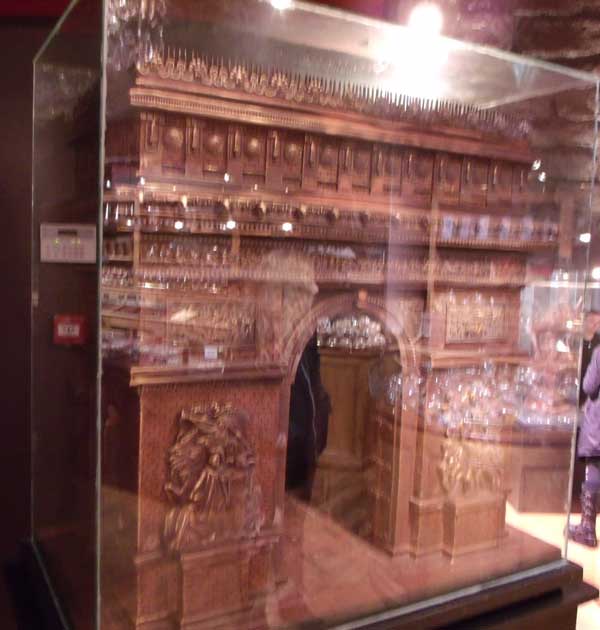
Monday, May 23, 2016
Up early
7:30, Breakfast
8:35, Checked in on line with Delta for flight back home, then off in the rain to the Métro station.
We came up from the Île de la Cité Métro station, site of the Notre Dame. Île de la Cité is one of two remaining natural islands in the Seine within the city of Paris, and the location of the medieval city.

Notre Dame, one of the finest examples of French Gothic architecture, was among the first buildings in the world to use the flying buttress. The building was not originally designed to include the flying buttresses around the choir and nave, but after the construction began the thinner walls grew ever higher and stress fractures began to occur as the walls pushed outward. Later the church was enlarged by simple enclosing the buttresses.
In 1160, Bishop Maurice de Sully deemed the previous Paris cathedral, Saint-Étienne of the 4th century, a bit dated and ordered the construction of Notre Dame.
The day we visited, they were setting up a platform for a choir near the entrance, which broke up the visuals a bit, blocking a long view of the interior.
Notre Dame is 130 meters long, 48 meters wide, and 35 meters high. That is 115 feet high, and built in the 12th century, without modern cranes. The rose windows have a diameter of 10 meters.
.
.
1163 Cornerstone laid for Notre-Dame de Paris; construction begins.
1182 Apse and choir completed, work begins on western facade.
1208 Nave vaults nearing completion.
1225 Western facade completed.
1250 Western towers and north rose window completed.
c.1245–1260s Transepts remodeled in the Rayonnant style by Jean de Chelles then Pierre de Montreuil
1250–1345 Remaining elements completed.


Across the square was a huge tent, and within was a big celebration of different breads of France. They had huge ovens, live radio broadcasts, kids getting tours, videos of how bread is made, and the great smell of bread everywhere. It was called Fete des Pains.
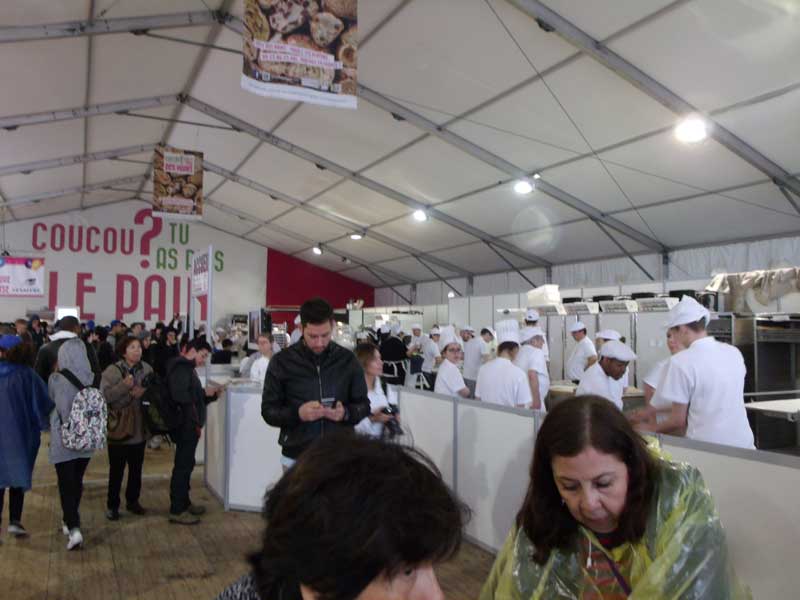
They even had massive decorative breads.
We then braved the rain, and walked across the bridge, and down a bit, to get some great views of Notre Dame.
Looking toward Hôtel de Ville
Final view of Notre Dame
We dropped down the to the RER station on the island, and rode to Jardin Luxembourg.
.
This was the one time we really wished we could visit when there was no rain.
.
11:15, Just across the street was L’Arlecchino, so we headed out of the rain for pizza, coffee, and a croque. €19,85
12:01, we headed to the Pantheon; built as a church, it now is a national monument, and the final resting place of many of France’s great people. €17,00
Under the great dome was Foucault's pendulum, named after the French physicist Léon Foucault, is a simple device conceived as an experiment to demonstrate the rotation of the Earth.
See my YouTube video of the pendulum, check out:
https://www.youtube.com/watch?v=e0vtvQHjF-4
.
Victor Hugo and Alexander Dumas
Braille
Voltaire
Model of the crypt area
We then pulled out our map, and wandered through the Latin Quarter...
... heading to the Arènes de Lutèce, an important ruin from the Gallo-Roman era in Paris (known in antiquity as Lutetia, or Lutèce in French). The amphitheater could once seat 15,000 people, and was used to present gladiatorial combats.
Constructed in the 1st century AD, this amphitheater is considered the longest of its kind constructed by the Romans. The sunken arena of the amphitheater was surrounded by the wall of a podium 2.5 m (8.2 feet) high, surmounted by a parapet. There was also a 41.2-m- (135-foot-) long stage. When Lutèce was sacked during the barbarian invasions of 280 A.D., some of the structure's stone work was carted off to reinforce the city's defenses around the Île de la Cité. Later, the amphitheater became a cemetery, and then it was filled in completely following the construction of wall of Philippe Auguste (ca. 1210).
Centuries later, even though the surrounding neighborhood (quartier) had retained the name les Arènes, no one really knew exactly where the ancient arena had been. It was discovered during the building of the Rue Monge between 1860–1869, when the Compagnie Générale des Omnibus sought to build a tramway depot on the site.
Spearheaded by the author Victor Hugo (1802–1885) and a few other intellectuals, a preservation committee called la Société des Amis des Arènes undertook to save the archaeological treasure.
As we arrived at the site, the rain finally let up a bit.
One entrance was like walking into a corridor in a building led to the floor, so we walked around to a park area, up the embankments, to get a better view.
.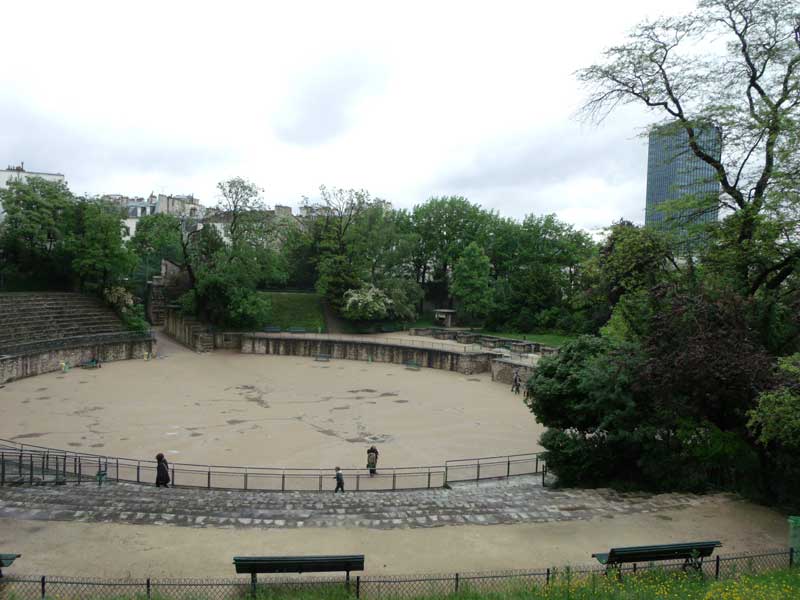
We then set off to see the grand Opera, after watching an organ grinder and his cats. See my YouTube video of the cats, check out:
https://www.youtube.com/watch?v=e0vtvQHjF-4
After finishing at the Opera, we headed back to Montmartre… time to by some last minute souvenirs €7,00.
We stopped at the Pret A Manger for soup (€11,90), then headed to the FranPrix to get some snacks for the plane. We stopped by our favorite Patisserie, Pain en Fete, and picked up a couple of items they called Divorces, because of the fight between flavors. €4,20.
Then, back to the hotel to pack, and settle in.
Tuesday, May 24, 2016
Paris to Atlanta
2:00, up VERY early, finished our cookies and finalized our packing.
4:00, down stairs, and checked out.
4:30, the crowded shuttle picked us up, then we grabbed two more folk near the Champs-Élysées before heading to CDG.
5:30, Tipped the driver €2,65, checked in the kiosks, went through security fairly quickly, got Susann some Starbucks €4,20, and settled into our gate.
6:55, changed €75 for $67.
7:40 boarding began on the A320, seats 38 A and B.
During the flight I watched the Revenant, Heart of the Sea, and we both watched Sizarro, and Casablanca.
For “lunch” we had chicken and omelets, with bread, cheese and fruit. Our midway snack was Ice Cream, crackers and cheese, and just before landing we had a cheese pannini.
12:01pm landed in Atlanta.
1:30pm, finally got past the badly managed passport control, where ½ the people were sent to extended screening. We then took the train from terminal F to A 20.
2:00pm, boarded the plane, and took seats 40B and C on the 757… a big guy had seat A, and he spent a lot of time in my ‘air space.’ We watched Top Gear on our last let: Atlanta to Austin.
3:45pm, Gracie met us at the gate, we picked up our car and we took Gracie to her car, before heading to Torchy’s in Round Rock for dinner.
Austin to Temple was a pretty quick run, we got unpacked and collapsed… but it was a wet, but great, trip.
FastPark & Relax https://www.thefastpark.com/location/austin/
Fodor's French Travel Phrases http://www.fodors.com/language/french/
Paris Metro Pass info http://booking.parisinfo.com/il4-offre_i146-transports-a-paris-ratp.aspx
See below for some of Fodor's 20 Free things to do in Paris http://www.fodors.com/world/europe/france/paris/experiences/news/photos/top-20-free-things-to-do-in-paris
TVG Bullet train Paris to Luxembourg http://en.voyages-sncf.com/en/train-ticket/
Hop On, Hop Off tour of Luxembourg http://www.city-sightseeing.com/tours/luxembourg/luxembourg.htm
From Fodor's 20 Free things to do in Paris
July 17, Arrive Marriott Marquis
Room 10-002

Fusion Opening and Awards
Video Wall, Palmer Alley
YouTube Video of Video Wall at Palmer Alley, and the Navy Band at the Naval Memorial (https://youtu.be/7LKI5CFiqaE)
July 18, Marriott Convention levels
Fusion Exhibit Floor
Fusion Keynote Hall
Fusion Event, at the Newseum
The Glass Elevators had bars set up in them... called the Party-vator
View from the Newseum deck, towards the Capitol
July 19
Sir Ken Robinson
After the closing, off for dinner at Paul, near the Navy Memorial
Sitting by the Navy Memorial, with the National Archives behind us
We got lucky, the Navy Memorial was hosting the Navy Band... we got to see the ceremonial entry practice while we ate.
YouTube Video of Video Wall at Palmer Alley, and the Navy Band at the Naval Memorial (https://youtu.be/7LKI5CFiqaE)
The Navy Band performance, with Color Guard and Drill Team
We then walked to the Mall, passing the Smithsonian Castle
Nice view of the Castle, and the Capitol
Passed the Washington Monument...
... on our way to the MLK Jr. Memorial.
Across the Tidal Basin, the Jefferson Memorial
On the way back, some nice views of the WWII Memorial, and the Lincoln Memorial
The moon peeking from behind the Washington Memorial
The White House